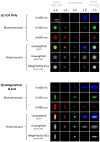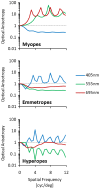Chromatic cues for the sign of defocus in the peripheral retina
- PMID: 39296412
- PMCID: PMC11407258
- DOI: 10.1364/BOE.537268
Chromatic cues for the sign of defocus in the peripheral retina
Abstract
Detecting optical defocus at the retina is crucial for accurate accommodation and emmetropization. However, the optical characteristics of ocular defocus are not fully understood. To bridge this knowledge gap, we simulated polychromatic retinal image quality by considering both the monochromatic wavefront aberrations and chromatic aberrations of the eye, both in the fovea and the periphery (nasal visual field). Our study revealed two main findings: (1) chromatic and monochromatic aberrations interact to provide a signal to the retina (chromatic optical anisotropy) to discern positive from negative defocus and (2) that chromatic optical anisotropy exhibited notable differences among refractive error groups (myopes, emmetropes and hyperopes). These findings could enhance our understanding of the underlying mechanisms of defocus detection and their subsequent implications for myopia control therapies. Further research is needed to explore the retinal architecture's ability to utilize the optical signals identified in this study.
© 2024 Optica Publishing Group.
Conflict of interest statement
LZ: Clerio Vision (E, P), CL: None, SW: Clerio Vision (C)
Figures









Similar articles
-
Quantifying monochromatic and polychromatic optical blur anisotropy in the periphery of myopes and emmetropes using a radial asymmetry metric.Front Med (Lausanne). 2025 Feb 10;12:1496210. doi: 10.3389/fmed.2025.1496210. eCollection 2025. Front Med (Lausanne). 2025. PMID: 39995693 Free PMC article.
-
Optical and Visual Diet in Myopia.Invest Ophthalmol Vis Sci. 2025 Jun 5;66(7):3. doi: 10.1167/iovs.66.7.3. Invest Ophthalmol Vis Sci. 2025. PMID: 40471573 Free PMC article. Review.
-
Peripheral optical anisotropy in refractive error groups.Ophthalmic Physiol Opt. 2023 May;43(3):435-444. doi: 10.1111/opo.13104. Epub 2023 Feb 7. Ophthalmic Physiol Opt. 2023. PMID: 36751123
-
Sign-dependent sensitivity to peripheral defocus for myopes due to aberrations.Invest Ophthalmol Vis Sci. 2012 Oct 17;53(11):7176-82. doi: 10.1167/iovs.11-9034. Invest Ophthalmol Vis Sci. 2012. PMID: 23010640
-
Mechanisms of emmetropization and what might go wrong in myopia.Vision Res. 2024 Jul;220:108402. doi: 10.1016/j.visres.2024.108402. Epub 2024 May 4. Vision Res. 2024. PMID: 38705024 Review.
Cited by
-
Visual Quality and Accommodation With Novel Optical Designs for Myopia Control.Transl Vis Sci Technol. 2024 Dec 2;13(12):6. doi: 10.1167/tvst.13.12.6. Transl Vis Sci Technol. 2024. PMID: 39630438 Free PMC article.
-
Chromatic imaging properties of myopia control spectacle lenses.Biomed Opt Express. 2025 Mar 19;16(4):1499-1512. doi: 10.1364/BOE.545932. eCollection 2025 Apr 1. Biomed Opt Express. 2025. PMID: 40322011 Free PMC article.
-
Quantifying monochromatic and polychromatic optical blur anisotropy in the periphery of myopes and emmetropes using a radial asymmetry metric.Front Med (Lausanne). 2025 Feb 10;12:1496210. doi: 10.3389/fmed.2025.1496210. eCollection 2025. Front Med (Lausanne). 2025. PMID: 39995693 Free PMC article.
-
Retinal Responses to Short- and Longer-Term Predominant ON or OFF Stimulation in Emmetropes and Myopes.Invest Ophthalmol Vis Sci. 2025 Feb 3;66(2):66. doi: 10.1167/iovs.66.2.66. Invest Ophthalmol Vis Sci. 2025. PMID: 40009370 Free PMC article.
-
Optical and Visual Diet in Myopia.Invest Ophthalmol Vis Sci. 2025 Jun 5;66(7):3. doi: 10.1167/iovs.66.7.3. Invest Ophthalmol Vis Sci. 2025. PMID: 40471573 Free PMC article. Review.
References
Associated data
LinkOut - more resources
Full Text Sources
Miscellaneous
